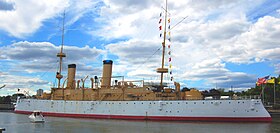USS Olympia (C-6)
 USS Olympia (C-6) |
|
| Overview | |
|---|---|
| Keel laying | June 17, 1891 |
| Launch | November 5, 1892 |
| 1. Period of service |
|
| Commissioning | February 5, 1895 |
| Decommissioning | until December 9, 1922 |
| Whereabouts | Museum ship |
| Technical specifications | |
| displacement |
5,586 ts |
| length |
104.88 m (344 ft, 1 in) |
| width |
16.17028 m (53 ft, 0.625 in) |
| Draft |
6.55 m (21 ft, 6 in) |
| crew |
33 officers, 395 NCOs and men |
| drive |
|
| speed |
22 knots |
| Armament |
|
| Armor | |
| Bunker quantity |
400 - 1093 ts of coal |
USS Olympia (C-6) is a protected cruiser of the United States Navy , named for Olympia , capital of the State of Washington . During the Spanish-American War , she took part in the Battle of Manila Bay in 1898 as the flagship of the commander of the Asian squadron, George Dewey .
She is the oldest surviving steel ship in the US Navy and a National Historic Landmark .
history
Development and construction
The ship was laid down on June 17, 1891 and was launched on November 5, 1892. The USS Olympia was baptized in her name by Miss Ann B. Dickie on November 5, 1892, and commissioned on February 5, 1895.
commitment
She served as the flagship of the US Navy's Asian squadron during the Spanish-American War in 1898 and took part in the Battle of Manila Bay under the command of Commodore George Dewey . In 1899 she went back to the USA. It was decommissioned on November 8 and returned to service in January 1902. From 1902 to 1906 she was active in the Atlantic , the Caribbean and the Mediterranean ; their commanders included the future Commander in Chief of the US Navy, William H. Standley . On April 1, 1906, she was decommissioned again in Norfolk . She was put back into service on May 15, 1907. From 1909 she was a training ship of the Naval Academy and from 1912 to 1916 she served as a barracks ship. Finally it was put into service again in 1916. During the First World War and the first post-war years, it operated as part of the Allied intervention in the Russian Civil War in the Atlantic and the Arctic , as well as in the Mediterranean. It was finally retired on December 9, 1922.
It was restored to its original condition from 1898 in 1957. In January 1964, the Olympia was awarded the status of a National Historic Landmark . It has been listed as a structure on the National Register of Historic Places since October 1966 . Since 1996 she has been a museum ship in the Independence Seaport Museum , Penn's Landing, Philadelphia. The two vertical triple expansion machines are of technical historical value.
Web links
Individual evidence
- ↑ USS Olympia
- ↑ OLYMPIA, USS (Cruiser) ( page no longer available , search in web archives ) Info: The link was automatically marked as defective. Please check the link according to the instructions and then remove this notice. in the National Historic Landmark Program , accessed January 28, 2015, English
- ↑ Listing of National Historic Landmarks by State: Pennsylvania. National Park Service , accessed February 14, 2020.
- ↑ USS OLYMPIA on the National Register of Historic Places , accessed February 14, 2020.
- ↑ asme.org, accessed on June 22, 2012
Coordinates: 39 ° 56 ′ 36.6 ″ N , 75 ° 8 ′ 27.5 ″ W.